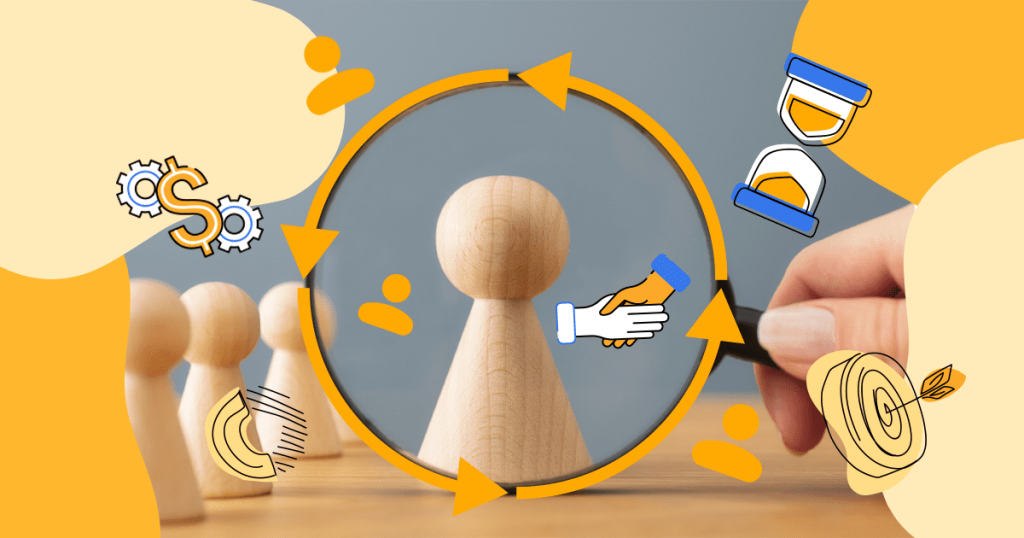Good relationships with customers tend to thrive for years. That’s why one of the most important assets your company has is a good customer lifecycle management (CLM) process.
But what does CLM mean, and what does it have to do with Digital Marketing?
The customer lifecycle process consists of managing the segments of the customer journey in stages — from onboarding to renewal.
Such a process allows you to focus on the particulars of each of those segments. That includes finding the right KPIs and metrics to manage performance on every step.
In its essence, it’s a process developed by the marketing department to set goal-based milestones and benchmarking the relationship with customers.
In this article, you will understand the meaning of customer lifecycle management and learn how to start this process in your company. You will see:
- What is the difference between the customer lifecycle and the customer journey?
- What are the 5 main stages of the customer lifecycle?
- How to manage the customer lifecycle?
- What are the benefits of customer lifecycle management for companies?
Ready to find out the answers? Keep on reading!
What is the difference between the customer lifecycle and the customer journey?
You might be wondering: what is the difference between the customer lifecycle and the customer journey? Aren’t they both related to how a consumer interacts and therefore engages with your company?
Yes and no. The customer lifecycle is how a company interacts with the customers throughout their relationship. This term refers to the way your business manages the customer experience as a whole.
On the other hand, the customer journey considers the point of view of the client. It starts with awareness and ends with any post-sale contacts. That could mean, for example, an evaluation request for the products in your store.
Although both are marketing terms, the customer lifecycle didn’t come into play until the creation of the first CRM system.
That type of software aims to compile all interactions between customers and companies and defined how we look into both concepts.
What are the 5 main stages of the customer lifecycle?
Now that you are aware of what customer lifecycle management is, it is time to realize one thing: there is not a one-size-fits-all solution to this process.
Managing the customer lifecycle must consider your business’ processes and what your company does for customers.
A successful CLM is related to your business’s actions to keep a customer close, even after they have completed a deal.
Therefore, it does not stop at the sale. Customer lifecycle management also involves the support your company offers and how well regarded by the clients this support is.
If you want to visualize the CLM, it will be easy to do so by comparing it to the sales funnel.
Each stage gets narrower as the customer goes along. After all, abandonment, attrition, and churn play a relevant role in why customers give up on your product.
A good CLM strategy should consider those factors, as they will help understand why you are failing.
However, while customer lifecycle management is different for each company, there are some usual stages in the process that you must consider, no matter what industry you work on.
Such stages are brand awareness, acquisition, conversion, retention, and loyalty. Below, we will look at this in detail to get a better picture of how customer lifecycle management works.
1. Brand awareness
The first step in the customer lifecycle is when a company reaches the customer.
Brand awareness is the concept of your client knowing what your business does and being aware of its quality.
You can achieve this in many ways, including ads, search engine marketing, branded content, landing pages, and social media presence.
2. Acquisition
The acquisition is how we refer to the point of the process where your customer decides to give you contact information, such as an email address or a telephone number.
That contact aims to help your business develop a relationship with the client and prospect them. It involves understanding their pain points and showing how your product can help them.
3. Conversion
When a prospect learns about your products and places an offer, that is called a conversion. Conversions are among the most relevant business goals, being responsible for most of the revenue of companies.
For a lot of businesses, conversion is the end goal of customer lifecycle management.
However, you should go beyond that, involving support and loyalty, which we will discuss in the next topics!
4. Retention
Retention is the ability a company has to maintain its customers satisfied and doing business with it.
For companies in e-commerce, for example, retention might mean up-selling or cross-selling products. But, for most businesses, it just means gaining a recurring customer, satisfied with the quality of your products and services.
5. Loyalty
Loyalty is another essential step in CLM. When you retain consumers for a long period, and they start to promote your brand, you have loyal consumers.
A loyal consumer might also be referred to by the term “brand advocate”. Some companies are famous for their brand advocates, like Apple and Samsung.
How to manage the customer lifecycle?
Once you have defined all the steps that are part of your customer lifecycle, like we did in the last topic, it’s time to manage it.
Here are a few steps to help you get started!
Understand your consumer with data
Data is fundamental for marketers, and data-driven strategies tend to be more successful than those based on unproven assumptions.
Therefore, if you want to use your customer lifecycle management to get better engagement, you should get familiar with spreadsheets.
Each of your customers might have different needs in their lifecycle, and meeting such demands helps keep them close, engaged, and purchasing. Thus, you must look at their data to best serve their needs.
Define KPIs for each customer lifecycle stage
KPIs (Key Performance Indicators) are a great way to understand if your company is reaching its goals.
As each stage of the lifecycle has its particulars, you should define KPIs to measure them and ensure your team’s work is reaching its goals.
For example, you might want to check if your SaaS clients are using the tool they bought. It can help you understand their engagement level.
On the other hand, you might want to look into how many of them purchased your solution to see if your conversion efforts are turning profits.
Share your data
Even though the marketing department is the most interested in consumer data regarding customer lifecycle, all company members should have such data in their hands. After all, it can improve their results.
Make sure your data is easily readable and accessible to other departments within the company.
Using software built for customer lifecycle management, such as CRM, is a great way to share actionable data with your team and make sure the customer lifecycle is well-documented.
What are the benefits of customer lifecycle management for companies?
Now that you have a good understanding of customer lifecycle management let’s talk about how it can benefit your business.
Check out the benefits!
Customer Lifecycle is a business strategy
More than just a marketing strategy, customer lifecycle management can help your company generate value for consumers.
The whole process should help every team member identify their role in making your business great and put effort into it.
That’s because the customer lifecycle embraces more than just selling. It’s about creating a good experience for your consumers to help them engage more with your brand.
CLM is a competitive advantage
Companies that employ customer lifecycle management are more successful than those that don’t.
There is a simple reason for that: they can build stronger pipelines and generate recurring revenue with ease.
All the data you need to analyze for the customer lifecycle helps you build knowledge to identify opportunities, reduce costs, or promote products.
Customer lifecycle management can simplify your operations
Can you imagine how much easier your life would be if your company didn’t have any overlapping systems or products? Such issues often make for a worse experience for customers.
CLM can help you center client information in only one place. That simplifies data access and management by marketing, operations, and sales departments.
Customer lifecycle management is a relevant thing for many businesses, bringing benefits like better customer retention and profits.
As we saw in this article, CLM is a different process in each company. Therefore, use wisely what you just learned, making changes when needed to suit your business’ best interest.
Ready to start building a better customer journey for your clients? So check out what customer satisfaction is and how it can increase your revenue!







